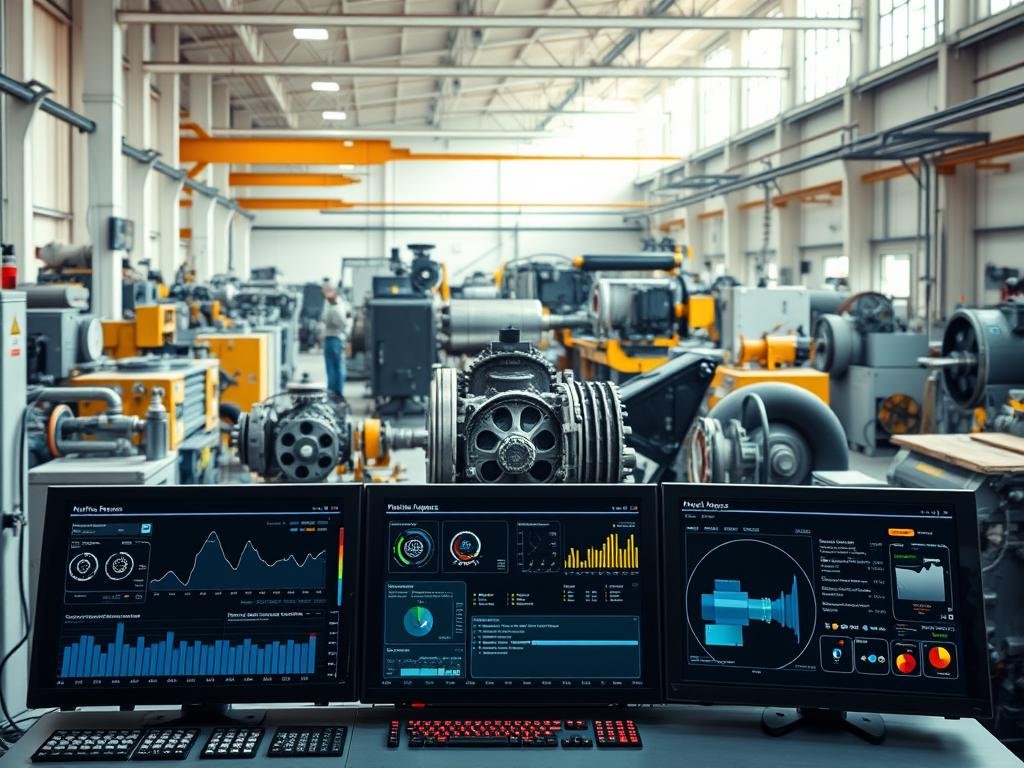Predictive Maintenance of Gadgets. Ever had a gadget just stop working without warning? It’s really frustrating. AI is changing how we keep our gadgets running. It helps predict when they need maintenance, cuts down on downtime, and makes things more efficient. For example, General Motors is using generative AI to make vehicle parts better, showing AI’s power in keeping gadgets in top shape.
By adding AI to our gadgets, we can make them last longer and work better. This is key, given that 72% of U.S. homes now have smart devices. This means we really need good ways to take care of our gadgets.
Key Takeaways
- AI enhances gadget lifespan through predictive maintenance.
- Predictive maintenance reduces downtime and improves efficiency.
- Companies like General Motors are already leveraging AI for maintenance.
- Smart devices are becoming increasingly prevalent in U.S. households.
- AI integration can significantly improve gadget performance.
Understanding Predictive Maintenance
Predictive maintenance is changing how we take care of our gadgets. It makes sure they work well and last longer. By using data and analytics, you can know when to do maintenance, avoiding sudden breakdowns and saving on repair costs.
What is Predictive Maintenance?
Predictive maintenance uses new technologies to watch over your gadgets in real-time. This way, you can fix small problems before they get big, making your gadgets better to use.
Why is It Important for Gadgets?
Predictive maintenance is key for keeping gadgets in top shape. It’s all about smart device upkeep, making sure your devices work their best. By using predictive maintenance, you get many predictive maintenance benefits, like:
- Less downtime because of sudden failures
- Lower repair costs by fixing problems early
- Longer life for your gadgets
- Better user experience with consistent performance
To learn more about how predictive maintenance boosts efficiency, check out enhancing efficiency with predictive maintenance.
The Role of AI in Preventive Maintenance
Artificial Intelligence (AI) is changing how we keep our gadgets running smoothly. It uses data analysis and real-time monitoring to stop gadgets from breaking down. This means less downtime and more efficiency.
How AI Analyzes Data
AI looks at data from IoT devices to figure out when maintenance is needed. It uses smart algorithms to spot patterns and oddities. This lets predictive maintenance software predict when gadgets might fail.
As a top expert says, “The future of maintenance is predictive, and AI is at the forefront of this revolution.” This shows how vital AI is for gadget health monitoring. It keeps your devices running at their best.
Real-Time Monitoring Capabilities
AI’s real-time monitoring is a big plus for preventive maintenance. It lets you act fast when a problem is spotted. This way, you can avoid gadget failures before they happen.
Using AI for maintenance makes your gadgets more reliable and last longer. As tech keeps getting better, AI’s role in keeping gadgets in top shape will grow even more important.
Benefits of Predictive Maintenance
Predictive maintenance can save you a lot of money and make your gadgets work better. It lets you know when to fix things before they break, saving you from costly repairs and downtime. This means more money saved and work done faster.
Cost Reduction and Efficiency
With predictive maintenance, you can plan when to do maintenance without disrupting your work. This way, you spend less on repairs and avoid sudden, expensive breakdowns. Some key ways to save money include:
- Reducing emergency repairs: Catching problems early saves you from expensive fixes.
- Optimizing maintenance schedules: Plan maintenance when it won’t bother you as much.
- Extending the life of components: Regular checks help gadgets last longer, so you don’t have to replace parts as often.

Extended Lifespan of Your Gadgets
Predictive maintenance isn’t just about saving money; it also makes your gadgets last longer. By keeping them in good shape, you can make them work for you longer. This is done by:
- Regular health checks: Keeping an eye on your gadgets helps spot problems early.
- Timely interventions: Fixing small issues before they get big saves you from bigger headaches.
- Optimized performance: Gadgets run smoothly, which means less wear and tear.
By using predictive maintenance, you can make your gadgets last longer, save on maintenance, and work more efficiently.
Common Gadgets Benefiting from Predictive Maintenance
Predictive maintenance is changing how we take care of our gadgets. It makes them work better and last longer. AI and IoT help a lot in this.
Many gadgets in our daily lives can use predictive maintenance. These are things that get worn out easily.
Smartphones and Tablets
Smartphones and tablets are used a lot. Predictive maintenance finds problems early. This keeps them working well.
It can fix issues like:
- Battery wear
- Storage problems
- Slow performance
By watching these, you can fix your devices. This means updating software or cleaning storage.
Home Appliances
Home appliances like fridges and washing machines also need predictive maintenance. They’re key for daily life and big investments.
It helps with:
- Timely maintenance
- Preventing sudden failures
- Using less energy
For example, a smart fridge can check its temperature. A washing machine can spot issues like imbalance.
https://www.youtube.com/watch?v=mtam5QOlpaw
| Gadget | Common Issues | Predictive Maintenance Benefits |
|---|---|---|
| Smartphones | Battery drain, storage issues | Enhanced performance, extended battery life |
| Tablets | Slow performance, screen issues | Improved speed, preventive screen maintenance |
| Home Appliances | Breakdowns, energy inefficiency | Reduced downtime, optimized energy use |
Using predictive maintenance makes your gadgets work better. They’ll last longer and serve you better.
How to Implement Predictive Maintenance
To start predictive maintenance, find the right tools and methods for your gadgets. This approach keeps your devices healthy and efficient.
Choosing the Right AI Tools
Choosing the right AI tools is key for good predictive maintenance. Look for predictive maintenance software that can analyze your gadgets’ data. It should give insights into their health. Important features include:
- Real-time monitoring capabilities
- Advanced data analytics
- Customizable alerts and notifications
- Integration with existing systems
When picking AI tools, check if they work with your gadgets. Also, see how much support the vendor offers.
Data Collection Methods
Collecting data well is essential for gadget health monitoring. You can gather data in several ways, such as:
- Sensors on your gadgets to track temperature, vibration, and pressure.
- Regular manual checks to spot wear and tear signs.
- Software logs that record your gadgets’ performance and errors.
Using these methods together gives a full picture of your gadgets’ health. This helps you make smart maintenance choices.

Starting predictive maintenance needs a careful plan. This includes picking the right AI tools and collecting data well. Doing this boosts your gadgets’ reliability and life span.
Key Technologies Driving Predictive Maintenance
The future of predictive maintenance is being shaped by new technologies. These technologies analyze data and predict when maintenance is needed. It’s important to know about these key technologies to keep your gadgets in top shape.
Machine Learning Algorithms
Machine learning algorithms are at the core of predictive maintenance. They help systems learn from data, spot patterns, and predict future needs. By looking at past data, these models can forecast when a gadget might fail or need maintenance. This lets you act early to prevent problems.
Benefits of Machine Learning in Predictive Maintenance:
- Enhanced accuracy in predicting maintenance needs
- Ability to analyze complex data sets
- Improved decision-making capabilities
Internet of Things (IoT) Integration
The Internet of Things (IoT) is key in predictive maintenance. It connects devices and collects data in real-time. IoT sensors track things like temperature, vibration, and performance. This gives a full picture of a gadget’s health, helping predict failures and plan maintenance.
IoT integration offers several advantages, including:
- Real-time monitoring capabilities
- Enhanced data collection and analysis
- Improved gadget performance and lifespan

Together, machine learning and IoT are changing predictive maintenance. They help plan maintenance better, cut downtime, and make gadgets last longer.
| Technology | Role in Predictive Maintenance | Benefits |
|---|---|---|
| Machine Learning Algorithms | Analyzes data to predict maintenance needs | Enhanced accuracy, improved decision-making |
| IoT Integration | Enables real-time data collection and monitoring | Real-time monitoring, enhanced data analysis |
Challenges in Predictive Maintenance
Starting predictive maintenance can face hurdles like data privacy worries and mixing new tech with old systems. Knowing these challenges helps make sure your gadget maintenance goes well.
Data Privacy Concerns
One big issue is data privacy concerns. Gathering and analyzing data from gadgets brings up questions about who sees it and how it’s kept safe. Keeping sensitive info secure is key.
- Use strong data encryption
- Set up tight access controls
- Follow data protection laws
Dealing with these issues helps build trust in the predictive maintenance system. It makes sure your data is handled right.
Integration with Existing Systems
Another hurdle is integrating predictive maintenance tech with current systems. Many places have old systems that don’t fit with new predictive tools. This can cause problems and cost more.
- Check if new tech works with old systems
- Plan a step-by-step integration to avoid trouble
- Train people to use the new systems
Good planning and execution are needed for smooth integration. This makes sure predictive maintenance works well with your current setup.

By tackling these challenges, you can handle predictive maintenance’s complexities. This leads to cost savings and longer gadget life.
Future Trends in Predictive Maintenance
Predictive maintenance is on the verge of a big change. New trends will make it more efficient and tailored to your needs. As technology gets better, keeping your gadgets in top shape will become easier and more personal.
Big changes are coming to predictive maintenance, thanks to autonomous solutions. These solutions will let your gadgets fix problems on their own. This will make maintenance faster and more efficient.
The Rise of Autonomous Solutions
Autonomous solutions will change predictive maintenance a lot. They will let devices check their own health and do maintenance tasks. This will cut down on downtime and make your gadgets work better.
For example, a smart fridge might find a problem and fix it itself. It could even order parts for repair. This level of self-care will make smart device upkeep super easy.
Increased Customization
Another big trend is making predictive maintenance more personal. AI and machine learning will help create maintenance plans that fit your gadgets’ needs. This means your devices will last longer and work better.
Imagine a system that knows how you use your phone and keeps it running smoothly. It adjusts maintenance based on your habits. This way, you get a maintenance plan that’s just right for you.
By adopting these new trends, you’ll enjoy a more efficient and personalized way to keep your gadgets in top shape. It’s going to be a hassle-free experience.
Success Stories of AI in Predictive Maintenance
AI is making gadgets last longer. It helps predict and prevent failures. This cuts down on downtime and boosts efficiency.
A leading smartphone maker used AI for maintenance. It saw a 30% drop in warranty claims thanks to early fixes.
Case Studies of Consumer Electronics
AI has changed consumer electronics a lot. A smart home brand used IoT predictive maintenance. It watched for and forecasted failures in their products.
This smart move helped the brand:
- Cut maintenance costs by 25%
- Boosted customer happiness with less downtime
- Made products more reliable and longer-lasting
Here’s a quick look at their wins:
| Metric | Before AI Implementation | After AI Implementation |
|---|---|---|
| Maintenance Costs | $100,000 | $75,000 |
| Customer Satisfaction | 80% | 95% |
| Product Lifespan | 3 years | 4.5 years |
Insights from Major Manufacturers
Big names in tech talk about AI’s role in maintenance. A top tech company’s report shows AI’s key role in gadget health monitoring.
The report says AI predictive maintenance software has helped them:
- Spot failures accurately
- Plan maintenance for less downtime
- Boost product quality and reliability
Using AI for predictive maintenance can save money. It also makes gadgets more efficient and reliable.
Setting Expectation Levels
The success of predictive maintenance depends on knowing its strengths and weaknesses. When you start using predictive maintenance for your gadgets, it’s key to have realistic hopes. This way, you can get the most out of it.
Understanding Limitations
Predictive maintenance isn’t a catch-all solution. Its success relies on many things, like the gadget’s type, the data quality, and the AI tool’s complexity. For example, smart gadgets with top-notch sensors can give better data, making predictive maintenance work better.
To grasp its limits, think about these:
- The gadget’s design complexity and parts.
- The quality and amount of historical data available.
- If the predictive maintenance tools fit with your current systems.
Defining Maintenance Thresholds
Setting maintenance thresholds is a key part of predictive maintenance. It means deciding when to do maintenance based on data. These thresholds help avoid failures.
To set these thresholds well:
- Look at past maintenance data for patterns.
- Use AI to spot where failures might happen.
- Change the thresholds based on how the gadget is used and its environment.
By knowing its limits and setting the right maintenance thresholds, you can make the most of predictive maintenance. This ensures your gadgets work well and efficiently.
Getting Started with Predictive Maintenance for Your Gadgets
To start with predictive maintenance, follow a few simple steps. These steps will help you keep your gadgets in top shape. By using predictive maintenance strategies, you can make your devices last longer.
Practical Implementation Steps
First, pick the right tools and software for your gadget care. Look for AI-powered solutions that can analyze your device’s data. Think about what data you need and how to get it.
Ongoing Monitoring and Adjustments
After setting up predictive maintenance, keep a close eye on your gadgets. Check the data and insights from your tools often. This helps spot issues early. Be ready to tweak your maintenance plan as needed to keep your gadgets running smoothly.
FAQ
What is predictive maintenance, and how does it work for gadgets?
Predictive maintenance uses data and analytics to predict when a gadget might fail. This way, you can fix problems before they get worse. For gadgets, AI tools analyze sensor data to spot issues early.
How can AI help with predictive maintenance of gadgets?
AI helps by looking at gadget data, finding patterns, and predicting when maintenance is needed. It also watches gadgets in real-time, so you can act fast if there’s a problem.
What are the benefits of using predictive maintenance for gadgets?
Predictive maintenance helps gadgets last longer, saves money, and cuts downtime. It spots problems early, so you can fix them before they get expensive.
Which gadgets can benefit from predictive maintenance?
Many gadgets can use predictive maintenance, like smartphones, tablets, and smart home devices. They need sensors and AI tools to monitor and predict maintenance needs.
How do I implement predictive maintenance for my gadgets?
To start, pick the right AI tools and data collection methods for your gadgets. Choose tools that can analyze data and give insights. Make sure your gadgets have sensors and the right hardware.
What are some of the challenges associated with predictive maintenance?
Challenges include data privacy, integrating with existing systems, and the cost of AI tools and infrastructure.
How can I get started with predictive maintenance for my gadgets?
First, pick which gadgets need predictive maintenance. Then, choose AI tools and set up data collection. Keep an eye on how it’s working and make changes as needed.
What are some future trends in predictive maintenance that I should be aware of?
Future trends include more autonomous solutions, customization, and better machine learning algorithms. These will make predictive maintenance more effective and efficient.
How can I define maintenance thresholds for my gadgets?
To set maintenance thresholds, analyze your gadgets’ data to find when they need maintenance. This helps you know when to act before a problem gets worse.
What are some common data collection methods used in predictive maintenance?
Common methods include sensor data, log files, and user feedback. These help monitor gadgets and predict when they need maintenance.
